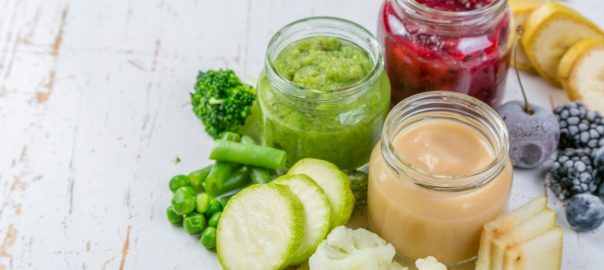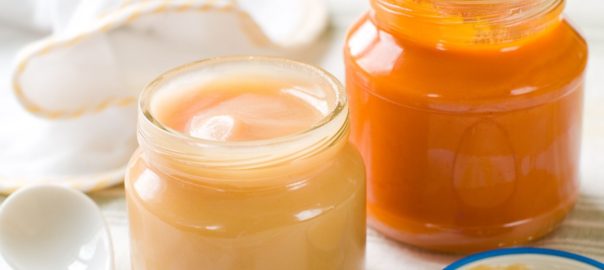When to introduce baby food
Infants first start out on a diet of breast milk (or baby formula) to provide necessary nutrients, vitamins, and natural antibodies. At five or six months old babies are usually ready to start having some semi-solid foods added to their diet. It’s around this age they stop showing the rooting or sucking instinct — the sign they’re ready for their first baby foods.
Adjusting to eating semi-solid foods is a big change for babies, and it will take time for them to get used to it. Soft pureed foods are the best food to start with. At first, feeding is likely to be messy and can take extra time as babies get used to the new tastes and textures of baby food. They may cry because they cannot get food fast enough, or spit out foods because they aren’t used to the texture. It’s also important to make sure babies are hungry by mealtime, but not overly hungry. Otherwise, excess hunger or lack of appetite can lead to frustration with the process of learning to eat semi-solids foods.
As babies start growing some teeth, they become able to chew foods. This is when you can start giving them slightly chunkier baby foods. Once they are able to sit up straight in a high chair, grasp food and move it to their mouths with their hands, they are ready to start having finger foods. Even though it takes time for babies to get used to new foods, it’s a good idea to give them a variety of vegetables and fruits. If they reject a food, replace it with something else and reintroduce the rejected food regularly. It normally takes six to ten times trying a food for babies to get used to new flavors, and can take even longer with naturally bitter or sour tastes. With time and patience, babies will develop a taste and appetite for the new kinds of food you add to their diet.
Food variety is key

When your baby is ready for solid foods, it’s important to think about what foods you’re going to feed them. I encourage a variety of pureed fruits and vegetables. Different tastes and textures in babies’ first foods are key to building preferences for nutritious options. It’s best to start with pureed foods and gradually change the texture of the foods. Including new textures in their food helps babies learn how to chew, and also aids speech development, which is important for their development.
Offering a wide variety of foods to your child will keep meals interesting and flavorful, and allow them to develop food preferences. Variety will also help them learn how to eat a healthy balanced diet, supporting your child’s growth and development. While there is no simple secret to preventing a toddler from becoming a picky eater, there are strategies that can help, such as changing the texture and size of the foods and introducing a variety of different flavors right from the start. Giving your baby plenty of opportunities to try new and different foods while they are still very young makes it more likely they will learn to enjoy those foods and accept them readily as they get older.
For babies, eating is a skill that has to be learned gradually. The earlier you introduce your child to a variety of food and flavors, the more willing they will be to try other foods. This will ultimately help them develop a broader palate and better eating habits throughout their lifetime.
Avoiding white rice cereals and snacks

What you feed your baby in infancy affects their eating habits in the long term. That is why feeding them a variety of nutritious, whole foods helps them develop healthy eating habits that can endure long after infancy. However, some foods can undermine their health and well-being. One of the major foods to avoid is white rice. When grains, like rice, are processed to make refined grains and flours, the majority of the nutritional content is removed at the same time.
White rice cereals are starches that trigger the natural preference for sweet foods that babies are born with. Even though this means they will likely accept it readily, it is not a healthy option. Feeding infants processed grains, like white rice cereal, as their first foods make it more likely for them to develop a preference for other refined grains. Because these foods are quickly converted to simple sugars during digestion, they can easily contribute to metabolic imbalances and overweight. Additionally, studies have shown white rice cereals and snacks intended for babies contained arsenic, a toxic contaminant that can harm children’s development. It’s much better to opt for high-quality whole grains instead of processed white rice products.
Homemade vs. store-bought baby food

Baby food is almost as varied and flavorful as adult food, anything can be pureed and put into a jar and called baby food. But there’s a big question to consider once your baby is ready to eat solids, should you make it at home or buy it at the store? Let’s consider the pros and cons of store-bought baby food vs. homemade baby food.
Benefits of homemade baby food:
- High nutrient content
- Great taste
- Cost effective
- Quality ingredients
- Control the ingredients
- Customize food blends
- Establish healthy eating habits
Homemade baby food is generally more nutritious and tastier than commercially processed foods, especially if it is made from fresh, whole foods. When you prepare baby food at home you can cook it in bulk batches, making it much more affordable than store-bought options. Making baby food at home also gives you complete control over the ingredients that go into it. You can pick high-quality produce, and choose what to add (or leave out), so you know exactly what you are feeding your baby. Homemade food lets you avoid preservatives, excess salt and sugar, and any foods to which your baby is allergic or sensitive. Plus, you can mix your own combinations of fruits, vegetables, and other purees to cater to your baby’s tastes and nutritional needs. Making baby food at home also allows you to incorporate your baby into your family’s eating habits, helping to establish healthy eating habits from the start.
Drawbacks of homemade baby food:
- Takes more time
- Measurements
- Needs refrigeration
- Safe food handling is necessary
Making baby food at home has a lot of potential benefits. But, it does take time to make and prepare lots of little servings of homemade baby food. Whereas prepackaged baby foods come in measured amounts ready to serve, at home you must do the extra step of portioning yourself. A great thing about fresh food is that it’s more nutritious, but it also spoils faster than some store-bought foods. You will need to have room to refrigerate or freeze fresh homemade baby food. Since homemade baby food is not pasteurized, you must take other food safety precautions to make sure it’s safe to eat (like properly washing food preparation and storage containers).
Benefits of store-bought baby food:
- Less preparation and cleaning
- Variety of food choices
- Convenience
- Portability
- Shelf stable
Store-bought baby food allows you to select foods for your baby quickly and conveniently. There is not much you have to prepare yourself when using pre-made baby foods. New products are constantly available, giving you a variety of foods to choose from. Because store-bought baby food is usually shelf stable, you do not have to worry about refrigeration (before opening the jar), allowing you to store it in a pantry area. That also means it’s often easier to take store-bought foods on the go without worrying about keeping them cold. Opt for the best quality foods you can get when choosing store-bought baby foods.
Drawbacks of store-bought baby food:
- Expensive
- Creates extra waste
- No control of ingredients
- May contain preservatives
- Fluoride content
- Contamination (heavy metals, pesticides, BPA)
Jarred baby foods can often cost more than making homemade alternatives, especially when you consider preparing foods in bulk and reusing good containers for homemade food. Store-bought baby food creates a lots of waste in the form of packaging, which you can largely avoid with homemade foods. Unlike homemade food, you have no control over what goes into commercial baby foods, giving you less control of the foods you feed your baby.
Another major problem with store-bought baby food is the additives and potential harmful ingredients. Baby foods often contain preservatives to make them more shelf stable (vitamin C is the only preservative that should be used in baby food). Baby food has also been found to contain fluoride, which can contribute to serious health problems if it’s consumed in excess during the first 2 years of life. Excess fluoride consumption before age 2 is damaging to dental health and brain development. Additionally, some research shows high fluoride intake in infancy may be linked to kidney disease. A recent study found detectable fluoride levels in all 360 samples of baby food and beverages that were tested.
Many other contaminants have been found in commercial foods, including a number of highly toxic pesticides. These pesticides can harm children’s brains and nervous systems, and include chemicals that are known neurotoxins and hormone disruptors, and possible carcinogens. Currently, there are no federal guidelines limiting pesticide levels to specifically protect infants and toddlers.
Many researchers and organizations are attempting to bring greater awareness to the problem of contaminants in baby food. The Environmental Working Group reported pesticides can be present in store-bought baby foods, and may also be present in the water used to make the baby food. According to Healthy Babies Bright Futures, the vast majority of packaged baby foods and snacks include one or more pesticides or heavy metals like arsenic or lead. Plastics can also cause contamination of baby food with bisphenols (like BPA) and other hormone disrupting chemicals.
These issues are definitely important to consider when deciding what to feed your developing child. While you may feed them a mix of homemade and store-bought foods, choosing those foods carefully is key to your baby’s health. Avoid foods stored in plastic packaging, those that contain unnecessary additives, and foods that have been found to be contaminated with pesticides and heavy metals.
Sources"Pesticides In Baby Food". Environmental Working Group, 1995, https://www.ewg.org/research/pesticides-baby-food.
"Emphasizing Variety In Baby's First Foods". Thebump.Com, 2021, https://www.thebump.com/a/introducing-variety-baby-first-foods. Accessed 8 June 2021.
"One Million Kids A Day Exposed To Unsafe Levels Of Toxic Pesticides In Fruit, Vegetables, And Baby Food". Environmental Working Group, 1998, https://www.ewg.org/news-insights/news-release/one-million-kids-day-exposed-unsafe-levels-toxic-pesticides-fruit. Accessed 8 June 2021.
Drgreene.Com, 2021, https://www.drgreene.com/ebooks/white_paper_white_rice_cereal.pdf. Accessed 8 June 2021.
"Study: Hidden Fluoride In Infant Foods Can Mar Babies’ Teeth". Fluoride Action Network, 2014, http://fluoridealert.org/news/study-hidden-fluoride-in-infant-foods-can-mar-babies-teeth/. Accessed 8 June 2021.
Thippeswamy, H. M. et al. "The Association Of Fluoride In Drinking Water With Serum Calcium, Vitamin D And Parathyroid Hormone In Pregnant Women And Newborn Infants". European Journal Of Clinical Nutrition, vol 75, no. 1, 2020, pp. 151-159. Springer Science And Business Media LLC, doi:10.1038/s41430-020-00707-2. Accessed 8 June 2021.
Jpeds.Com, 2021, https://www.jpeds.com/article/S0022-3476(20)30467-4/pdf. Accessed 8 June 2021.
"Exploring The Role Of Excess Fluoride In Chronic Kidney Disease: A Review - RW Dharmaratne, 2019". 2021, p. ., https://journals.sagepub.com/doi/abs/10.1177/0960327118814161. Accessed 8 June 2021.



